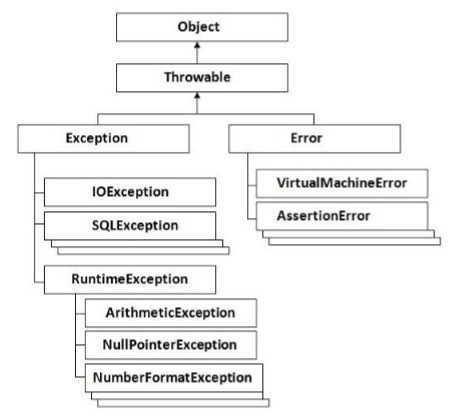任何编程语言都需要异常处理来处理运行时错误,从而可以保持应用程序的正常流程。
异常通常会破坏应用程序的正常流程,这就是为什么我们需要在我们的应用程序中使用异常处理的原因。
例外大致分为以下类别 -
检测异常 -扩展Throwable类(除了RuntimeException和Error)的类称为检查异常egIOException,SQLException等。检查的异常在编译时检查。
一个典型的情况是FileNotFoundException。假设您的应用程序中有以下代码,它从E盘中的文件读取。
class Example {
static void main(String[] args) {
File file = new File("E://file.txt");
FileReader fr = new FileReader(file);
}
}
如果文件(file.txt)不在E盘中,那么将引发以下异常。
抓取:java.io.FileNotFoundException:E:\ file.txt(系统找不到指定的文件)。
java.io.FileNotFoundException:E:\ file.txt(系统找不到指定的文件)。
未经检查的异常 -扩展RuntimeException的类称为未检查异常,例如,ArithmeticException,NullPointerException,ArrayIndexOutOfBoundsException等。未检查的异常在编译期不检查,而是在运行时检查。
一个典型的情况是ArrayIndexOutOfBoundsException,当您尝试访问大于数组长度的数组的索引时,会发生这种情况。以下是这种错误的典型例子。
class Example {
static void main(String[] args) {
def arr = new int[3];
arr[5] = 5;
}
}
当上面的代码执行时,将引发以下异常。
抓取:java.lang.ArrayIndexOutOfBoundsException:5
java.lang.ArrayIndexOutOfBoundsException:5
错误 -错误无法恢复。 OutOfMemoryError,VirtualMachineError,AssertionError等。
这些是程序永远不能恢复的错误,将导致程序崩溃。
下图显示了如何组织Groovy中的异常层次结构。它都基于Java中定义的层次结构。
方法使用try和catch关键字的组合捕获异常。 try / catch块放置在可能生成异常的代码周围。
try {
//Protected code
} catch(ExceptionName e1) {
//Catch block
}
所有可能引发异常的代码都放在受保护的代码块中。
在catch块中,您可以编写自定义代码来处理异常,以便应用程序可以从异常中恢复。
让我们看一个类似的代码示例,我们在上面看到一个索引值大于数组大小的数组。但这次让我们将我们的代码包装在try / catch块中。
class Example {
static void main(String[] args) {
try {
def arr = new int[3];
arr[5] = 5;
} catch(Exception ex) {
println("Catching the exception");
}
println("Let's move on after the exception");
}
}
当我们运行上面的程序,我们将得到以下结果 -
Catching the exception Let's move on after the exception从上面的代码,我们在try块中包装错误的代码。在catch块中,我们只是捕获我们的异常并输出一个异常已经发生的消息。
可以有多个catch块来处理多种类型的异常。对于每个catch块,根据引发的异常的类型,您将编写代码来相应地处理它。
让我们修改上面的代码来具体捕捉ArrayIndexOutOfBoundsException。以下是代码段。
class Example {
static void main(String[] args) {
try {
def arr = new int[3];
arr[5] = 5;
}catch(ArrayIndexOutOfBoundsException ex) {
println("Catching the Array out of Bounds exception");
}catch(Exception ex) {
println("Catching the exception");
}
println("Let's move on after the exception");
}
}
当我们运行上面的程序,我们将得到以下结果 -
Catching the Aray out of Bounds exception Let's move on after the exception从上面的代码,你可以看到ArrayIndexOutOfBoundsException catch块首先被捕获,因为它意味着异常的标准。
finally块跟在try块或catch块之后。代码的finally块总是执行,而不管异常的发生。
使用finally块可以运行任何你想要执行的清除类型语句,无论在受保护代码中发生什么。该块的语法如下。
try {
//Protected code
} catch(ExceptionType1 e1) {
//Catch block
} catch(ExceptionType2 e2) {
//Catch block
} catch(ExceptionType3 e3) {
//Catch block
} finally {
//The finally block always executes.
}
让我们修改我们上面的代码并添加finally代码块。以下是代码段。
class Example {
static void main(String[] args) {
try {
def arr = new int[3];
arr[5] = 5;
} catch(ArrayIndexOutOfBoundsException ex) {
println("Catching the Array out of Bounds exception");
}catch(Exception ex) {
println("Catching the exception");
} finally {
println("The final block");
}
println("Let's move on after the exception");
}
}
当我们运行上面的程序,我们将得到以下结果 -
Catching the Array out of Bounds exception The final block Let's move on after the exception
以下是Groovy中提供的异常方法 -
返回有关已发生异常的详细消息。此消息在Throwable构造函数中初始化。
返回由Throwable对象表示的异常原因。
返回与getMessage()的结果连接的类的名称。
将toString()的结果与堆栈跟踪一起打印到System.err,错误输出流。
返回包含堆栈跟踪上的每个元素的数组。索引0处的元素表示调用堆栈的顶部,数组中的最后一个元素表示调用堆栈底部的方法。
使用当前堆栈跟踪填充此Throwable对象的堆栈跟踪,添加到堆栈跟踪中的任何以前的信息。
下面是使用上面给出的一些方法的代码示例 -
class Example {
static void main(String[] args) {
try {
def arr = new int[3];
arr[5] = 5;
}catch(ArrayIndexOutOfBoundsException ex) {
println(ex.toString());
println(ex.getMessage());
println(ex.getStackTrace());
} catch(Exception ex) {
println("Catching the exception");
}finally {
println("The final block");
}
println("Let's move on after the exception");
}
}
当我们运行上面的程序,我们将得到以下结果 -
java.lang.ArrayIndexOutOfBoundsException: 5 5 [org.codehaus.groovy.runtime.dgmimpl.arrays.IntegerArrayPutAtMetaMethod$MyPojoMetaMet hodSite.call(IntegerArrayPutAtMetaMethod.java:75), org.codehaus.groovy.runtime.callsite.CallSiteArray.defaultCall(CallSiteArray.java:48) , org.codehaus.groovy.runtime.callsite.AbstractCallSite.call(AbstractCallSite.java:113) , org.codehaus.groovy.runtime.callsite.AbstractCallSite.call(AbstractCallSite.java:133) , Example.main(Sample:8), sun.reflect.NativeMethodAccessorImpl.invoke0(Native Method), sun.reflect.NativeMethodAccessorImpl.invoke(NativeMethodAccessorImpl.java:57), sun.reflect.DelegatingMethodAccessorImpl.invoke(DelegatingMethodAccessorImpl.java:43) , java.lang.reflect.Method.invoke(Method.java:606), org.codehaus.groovy.reflection.CachedMethod.invoke(CachedMethod.java:93), groovy.lang.MetaMethod.doMethodInvoke(MetaMethod.java:325), groovy.lang.MetaClassImpl.invokeStaticMethod(MetaClassImpl.java:1443), org.codehaus.groovy.runtime.InvokerHelper.invokeMethod(InvokerHelper.java:893), groovy.lang.GroovyShell.runScriptOrMainOrTestOrRunnable(GroovyShell.java:287), groovy.lang.GroovyShell.run(GroovyShell.java:524), groovy.lang.GroovyShell.run(GroovyShell.java:513), groovy.ui.GroovyMain.processOnce(GroovyMain.java:652), groovy.ui.GroovyMain.run(GroovyMain.java:384), groovy.ui.GroovyMain.process(GroovyMain.java:370), groovy.ui.GroovyMain.processArgs(GroovyMain.java:129), groovy.ui.GroovyMain.main(GroovyMain.java:109), sun.reflect.NativeMethodAccessorImpl.invoke0(Native Method), sun.reflect.NativeMethodAccessorImpl.invoke(NativeMethodAccessorImpl.java:57), sun.reflect.DelegatingMethodAccessorImpl.invoke(DelegatingMethodAccessorImpl.java:43) , java.lang.reflect.Method.invoke(Method.java:606), org.codehaus.groovy.tools.GroovyStarter.rootLoader(GroovyStarter.java:109), org.codehaus.groovy.tools.GroovyStarter.main(GroovyStarter.java:131), sun.reflect.NativeMethodAccessorImpl.invoke0(Native Method), sun.reflect.NativeMethodAccessorImpl.invoke(NativeMethodAccessorImpl.java:57), sun.reflect.DelegatingMethodAccessorImpl.invoke(DelegatingMethodAccessorImpl.java:43) , java.lang.reflect.Method.invoke(Method.java:606), com.intellij.rt.execution.application.AppMain.main(AppMain.java:144)] The final block Let's move on after the exception
